As a mom of three picky eaters, I discovered that Ginataang Gulay is my secret weapon for getting vegetables onto their plates - and into their bellies!
When I first made this dish, my children were skeptical of the kalabasa (squash) and sitaw (long beans), but the creamy sauce won them over instantly. Now when they smell the coconut milk simmering with garlic and onions, they actually hover around the kitchen asking, "Is it ready yet?"
The tender pork and shrimp don't hurt, either. They're like little treasures hidden among the vegetables that make each bite exciting. This recipe has become our family's proof that healthy can indeed be delicious, and I love knowing that an authentic Filipino dish is helping raise another generation of vegetable lovers.
Jump to:

Why You'll Love This Recipe
- Perfect balance of creamy coconut milk with tender-crisp vegetables
- One-pot meal that's both nutritious and satisfying
- Budget-friendly yet protein-rich with both pork and shrimp
- Versatile recipe that works with various vegetable combinations
- Ready in under an hour for a perfect weeknight dinner
Ingredients
The ingredients in this recipe work together to create the ultimate comfort food with authentic Filipino flavors. Kalabasa (squash) provides natural sweetness and a creamy texture when cooked, while sitaw (long beans) adds a fresh crunch and vibrant color.
The pork belly contributes rich, savory notes and satisfying fat that melts into the coconut milk, creating a luxurious mouthfeel. Shrimp adds a delicate seafood sweetness that balances the richness of the other components. The aromatic base of garlic, onions, and optional ginger and lemongrass infuses the coconut milk with depth and complexity.
Together, these ingredients create a harmonious blend of flavors and textures that has made this dish a Filipino favorite for generations.
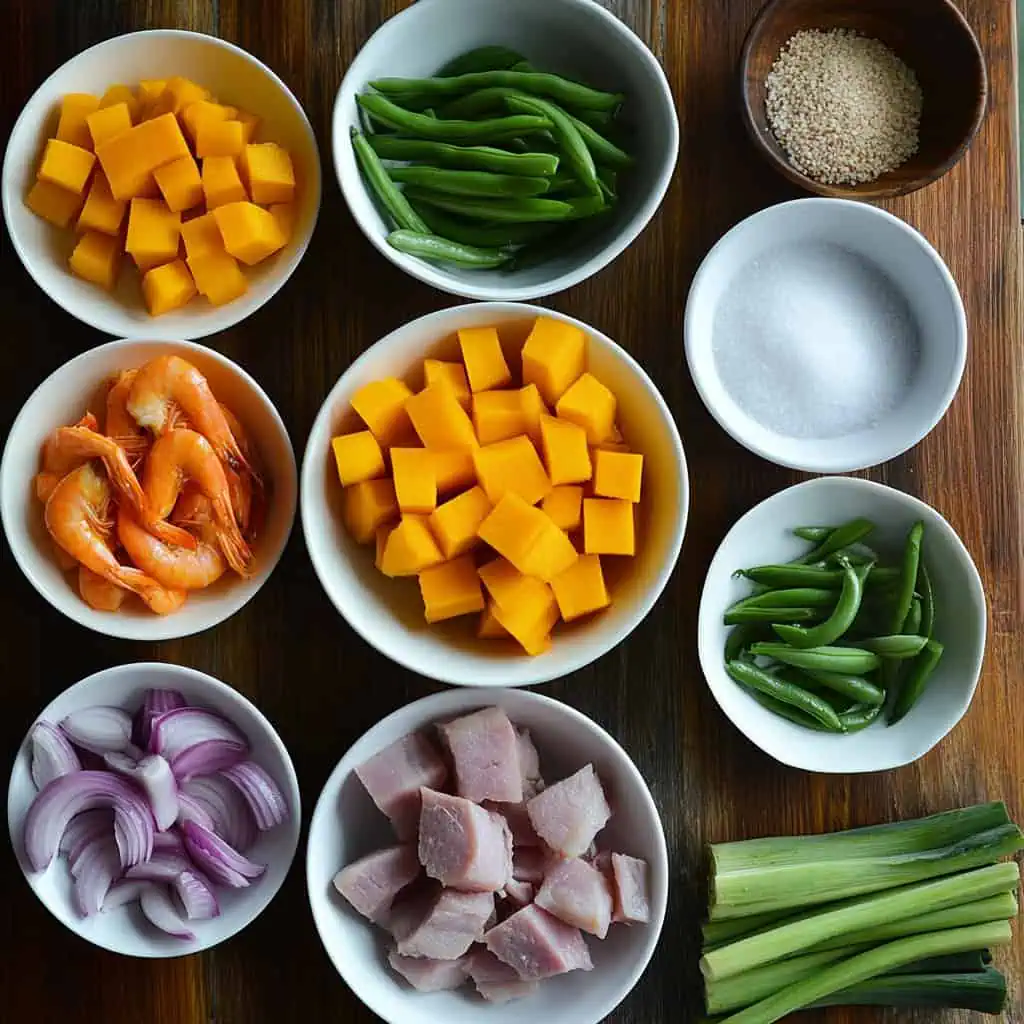
- 500g kalabasa (calabaza squash/pumpkin), cubed into 2-inch pieces
- 250g sitaw (snake beans/yard-long beans), cut into 2-inch lengths
- 300g pork belly (liempo), thinly sliced
- 300g medium shrimp (hipon), peeled and deveined
- 2 cans (400ml each) coconut milk (gata)
- 1 medium onion (sibuyas), finely chopped
- 6 cloves garlic (bawang), minced
- 2 tablespoons cooking oil
- 2 cups pork or shrimp stock
- Salt (asin) and pepper (paminta) to taste
Optional Aromatics:
- 3 pieces ginger (luya), sliced
- 2-3 pieces bird's eye chili (siling labuyo)
- 2 pieces lemongrass (tanglad), bruised
Equipment
- Large Heavy-Bottom Pot (Kaldero) - For even heat distribution and preventing coconut milk from burning
- Sharp knife (Kutsilyo) - For precise vegetable cutting, ensuring uniform cooking times
- Wooden spoon (Sandok na kahoy) - To prevent scratching the pot and gently stir without breaking the vegetables
- Measuring cups and spoons (Panukat) - For accurate measurements of ingredients
- Colander (Salaan) - For draining and rinsing vegetables before cooking
- Cutting board (Sangkalan) - For safe and hygienic food preparation

How To Make
- Heat oil in a large pot over medium heat. Add minced garlic and cook until fragrant, about 30 seconds. Add diced onions and cook until soft and clear, about 2-3 minutes.
- Add the sliced pork belly and cook until it starts to brown, about 5-7 minutes. Stir occasionally to prevent sticking.
- Pour in the coconut milk and pork stock. Add ginger and lemongrass if using them. Let the mixture come to a gentle simmer and season with salt and pepper to taste.
- Let everything simmer for 15-20 minutes until the pork becomes tender. Keep the heat at medium-low to prevent the coconut milk from curdling.
- Add the cubed kalabasa (squash) to the pot and cook for 5 minutes. The squash should be almost tender but not falling apart.
- Add the cut sitaw (snake beans) and cook for another 3-4 minutes. The beans should stay crisp-tender and bright green.
- Add the peeled shrimp and cook just until they turn pink, about 2-3 minutes. Don't overcook the shrimp or they'll become tough.
- Taste and adjust the seasoning. Remove the lemongrass stalks if you used them.
- Let the dish rest for 5 minutes before serving. This helps the flavors come together and lets the sauce thicken slightly.
- Serve hot with steamed white rice. Place patis (fish sauce) and calamansi halves on the side for people to add to taste.

Tips from Lola's Kitchen
- Use "native" kalabasa whenever possible – the darker orange flesh has more flavor and natural sweetness than imported varieties
- Cut vegetables in uniform sizes to ensure they cook evenly and look more appealing on the plate
- Cook vegetables in stages based on their density – squash needs more time than beans or leafy greens
- Save the shrimp shells and heads to make a quick stock that adds depth to the dish
- Slightly undercook the vegetables as they will continue cooking from residual heat after you turn off the flame
- Adding a splash of fish sauce at the end brightens the flavor without making it taste fishy
- For creamier texture, reserve ¼ cup of coconut cream to stir in just before serving
Substitutions
- Vegetables:
- Replace kalabasa with butternut squash, kabocha, or even sweet potatoes
- Substitute sitaw with regular green beans, sugar snap peas, or asparagus
- Add spinach, bok choy, or other leafy greens in the last 1-2 minutes of cooking
- Protein:
- Use chicken thighs instead of pork for a lighter option
- Try firm white fish chunks or squid rings instead of shrimp
- For vegetarian version, use firm tofu cubes or mushrooms like oyster or king trumpet
- For vegan option, use vegetable stock and double the vegetables
- Coconut Milk:
- Fresh coconut milk produces the best flavor but canned works well
- Light coconut milk can be used to reduce calories, though the sauce will be thinner
- In a pinch, coconut cream powder mixed with water or even cashew cream can work
Troubleshooting
- Curdled coconut milk: The key is temperature control. Always maintain a gentle simmer rather than a boil. If curdling occurs, stabilize the sauce by lowering heat immediately and adding a small amount of room-temperature coconut milk while stirring gently.
- Overcooked vegetables: Time each vegetable's addition carefully. Start with the longest-cooking ingredients first. If you notice vegetables cooking too quickly, remove them temporarily with a slotted spoon and return them at the end.
- Too thin sauce: Simmer uncovered for 5-7 additional minutes to reduce liquid. Alternatively, scoop out ¼ cup of the sauce, mix with 1 teaspoon cornstarch until smooth, then stir back into the pot and simmer for 2 minutes.
- Too thick sauce: Add warm stock or water, 2 tablespoons at a time, until you reach desired consistency. Stir gently after each addition.
- Bland flavor: Add fish sauce (patis) 1 teaspoon at a time, allowing flavors to incorporate before tasting again. Fresh calamansi juice or a pinch of sugar can also balance flavors.
Storage & Reheating
- Refrigeration: Store in airtight containers for up to 3 days. The flavors often improve overnight as they meld together.
- Not recommended for freezing: Coconut milk-based dishes tend to separate when frozen and thawed. The vegetables will also lose their texture.
- Reheating:
- Gently warm over medium-low heat, stirring occasionally to prevent scorching
- Add a splash of fresh coconut milk if the sauce has thickened too much
- Heat only until warmed through (about 165°F) to preserve the integrity of the vegetables and shrimp
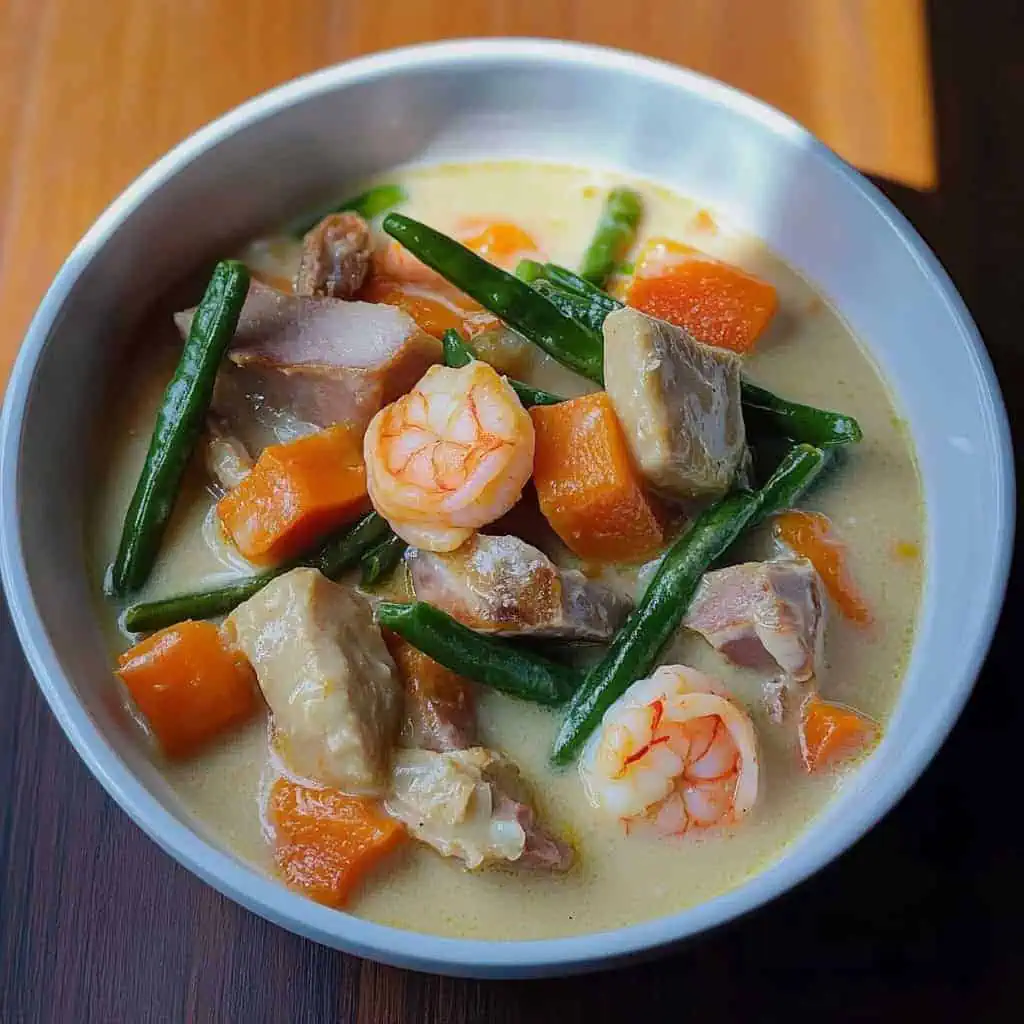
FAQ
Can I make this dish in advance for a party?
Yes, but I recommend cooking the base with pork and coconut milk a day ahead, then adding the vegetables and shrimp when reheating shortly before serving. This preserves their texture and color.
Is this recipe keto-friendly?
Yes! The dish is naturally low in carbohydrates, especially when served without rice. The fat content from coconut milk and pork makes it suitable for keto diets.
How can I make this spicier?
Add 1-3 whole bird's eye chilies (siling labuyo) during cooking for gentle heat that infuses the sauce. For more pronounced spice, crush the chilies slightly. You can also serve fresh chilies on the side for people to add according to their preference.
My family doesn't like shrimp. What can I use instead?
This recipe works beautifully with any protein. Try cubed chicken thighs, sliced beef, or even meatballs. For a seafood alternative, firm white fish like cod or snapper works well.
Can I add other Filipino vegetables to this dish?
Absolutely! Traditional additions include sayote (chayote), patola (ridge gourd), talong (eggplant), or even ampalaya (bitter gourd) for the adventurous. Just adjust cooking times based on each vegetable's density.
How do I know when the dish is done?
The perfect Ginataang Gulay has tender but not mushy vegetables, fully cooked but still juicy protein, and a sauce that coats the back of a spoon without being too thick or too runny. The color should be a creamy golden-yellow with vibrant vegetables peeking through.
Can I use pre-cut frozen vegetables to save time?
While fresh is always best for texture and flavor, frozen vegetables can work in a pinch. Thaw them completely and pat dry before adding to the pot, and reduce their cooking time by about 2 minutes since they're partially cooked.
Related
Looking for other recipes like this? Try these:

Ginataang Gulay (Filipino Vegetable Stew in Coconut Milk)
Equipment
- Large Heavy-Bottom Pot (Kaldero) For even heat distribution
- Sharp knife (kutsilyo) For precise vegetable cutting
- Wooden spoon (sandok na kahoy) To prevent scratching the pot
- Measuring cups and spoons (Panukat) For accurate measurements
- Colander (salaan) For draining vegetables
- Cutting board (Sangkalan) For food preparation
Ingredients
For the Base
- 500 g kalabasa calabaza squash/pumpkin, cubed into 2-inch pieces
- 250 g sitaw snake beans/yard-long beans, cut into 2-inch lengths
- 300 g pork belly liempo, thinly sliced
- 300 g medium shrimp hipon, peeled and deveined
- 2 cans 400ml each coconut milk (gata)
- 1 medium onion sibuyas, finely chopped
- 6 cloves garlic bawang, minced
- 2 tablespoons cooking oil
- 2 cups pork or shrimp stock
- Salt asin and pepper (paminta) to taste
Optional Aromatics
- 3 pieces ginger luya, sliced
- 2-3 pieces bird's eye chili siling labuyo
- 2 pieces lemongrass tanglad, bruised
Instructions
- Heat oil in a large pot over medium heat. Add minced garlic and cook until fragrant, about 30 seconds. Add diced onions and cook until soft and clear, about 2-3 minutes.
- Add the sliced pork belly and cook until it starts to brown, about 5-7 minutes. Stir occasionally to prevent sticking.
- Pour in the coconut milk and pork stock. Add ginger and lemongrass if using them. Let the mixture come to a gentle simmer and season with salt and pepper to taste.
- Let everything simmer for 15-20 minutes until the pork becomes tender. Keep the heat at medium-low to prevent the coconut milk from curdling.
- Add the cubed kalabasa (squash) to the pot and cook for 5 minutes. The squash should be almost tender but not falling apart.
- Add the cut sitaw (snake beans) and cook for another 3-4 minutes. The beans should stay crisp-tender and bright green.
- Add the peeled shrimp and cook just until they turn pink, about 2-3 minutes. Don't overcook the shrimp or they'll become tough.
- Taste and adjust the seasoning. Remove the lemongrass stalks if you used them.
- Let the dish rest for 5 minutes before serving. This helps the flavors come together and lets the sauce thicken slightly.
- Serve hot with steamed white rice. Place patis (fish sauce) and calamansi halves on the side for people to add to taste.
- For leftovers, let the dish cool completely before storing in an airtight container in the refrigerator. It will keep well for up to 3 days.
Tips from Lola's Kitchen
- Use native squash (kalabasa) for authentic flavor
- Cut vegetables in similar sizes for even cooking
- Don't overcook the sitaw to maintain crispness
- Add coconut cream (kakang gata) at the end for extra richness
- Let the dish rest for 10 minutes before serving
Nutrition
The Story Behind Ginataang Gulay
In the heart of Filipino home cooking lies Ginataang Gulay, a dish that perfectly exemplifies the culinary heritage of the Philippines' diverse regional cuisines. This beloved vegetable stew, whose name directly translates to "vegetables cooked in coconut milk," has its roots deeply embedded in the country's abundant coastal regions, where coconut trees flourish and fresh seafood is plentiful.
The tradition of cooking with coconut milk, or gata, dates back centuries in Philippine cuisine, reflecting the archipelago's strong connection to the coconut palm, often called the "tree of life" by locals. This cooking method was particularly prevalent in regions like Bicol, Southern Luzon, and various parts of the Visayas, where coconut plantations dominated the landscape and shaped local culinary traditions.
Ginataang Gulay emerged as a practical solution for Filipino mothers who sought to incorporate more vegetables into their family's diet while maintaining the rich, satisfying flavors that would appeal to everyone at the table. The genius of this dish lies in how it transforms simple, locally available ingredients – kalabasa (calabaza squash), sitaw (yard-long beans), and protein sources like pork and shrimp – into a luxurious, creamy stew that elevates these humble components.
The dish's evolution reflects the Filipino principle of "sustainable cooking" long before it became a global trend. Traditional cooks would use whatever vegetables were in season, adapting the recipe based on their garden's harvest or the local market's offerings. This flexibility has contributed to numerous regional variations, each adding its own local vegetables and preferred levels of coconut milk richness.
In modern Filipino households, Ginataang Gulay continues to hold its place as a beloved comfort food that bridges generations. It represents the perfect balance between nutrition and indulgence, making it a favorite among health-conscious food lovers who don't want to compromise on flavor. The dish has also gained recognition internationally as part of the growing appreciation for Filipino cuisine, with food enthusiasts discovering how the creamy coconut base perfectly complements the natural sweetness of squash and the fresh crunch of snake beans.
Today, this dish stands as a testament to Filipino culinary ingenuity, demonstrating how simple cooking techniques and readily available ingredients can create something truly extraordinary. Whether served in humble homes or upscale Filipino restaurants, Ginataang Gulay continues to tell the story of Philippine cooking – one that's deeply rooted in family, tradition, and the art of making everyday ingredients shine.
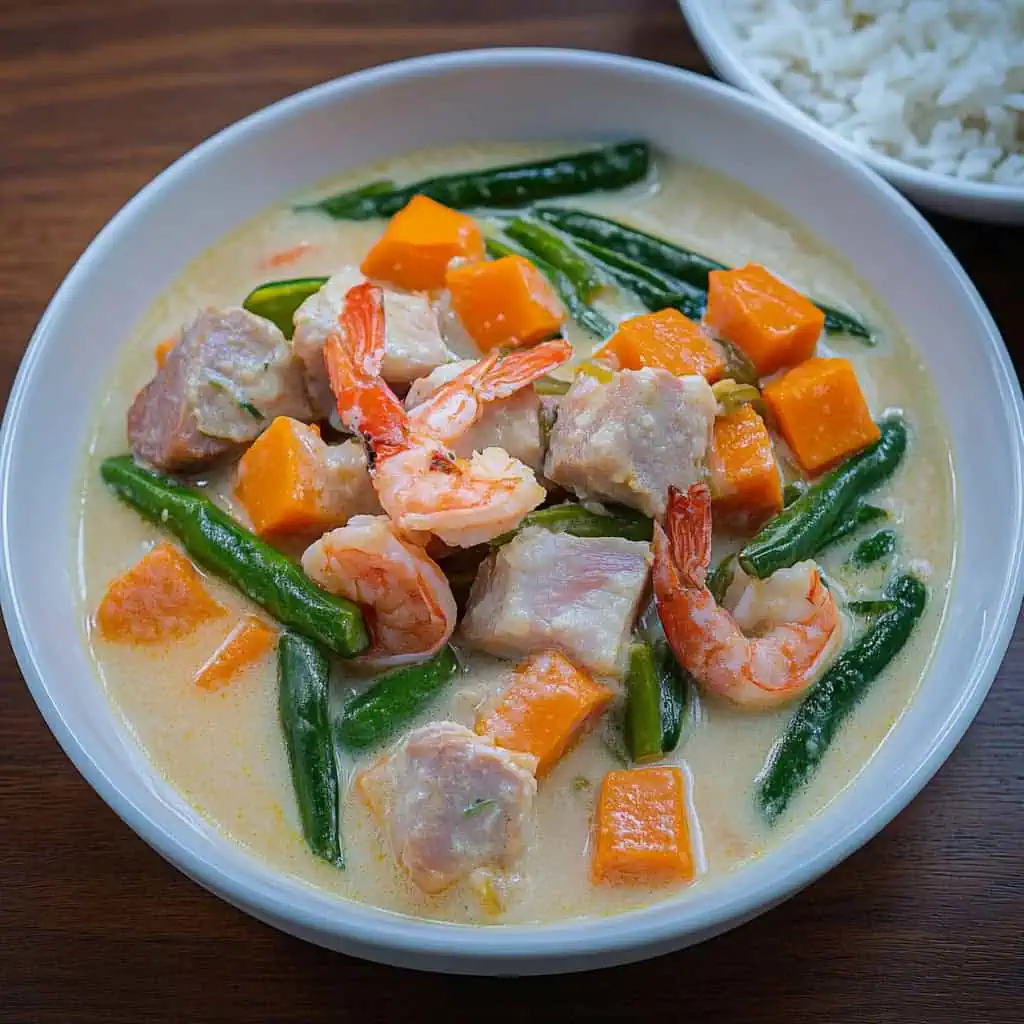






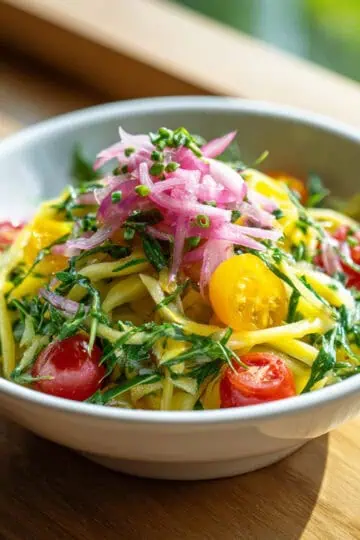
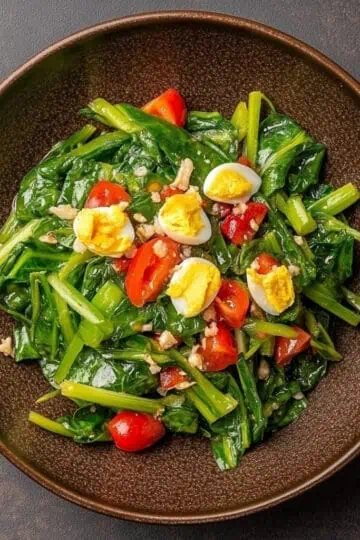

Comments
No Comments